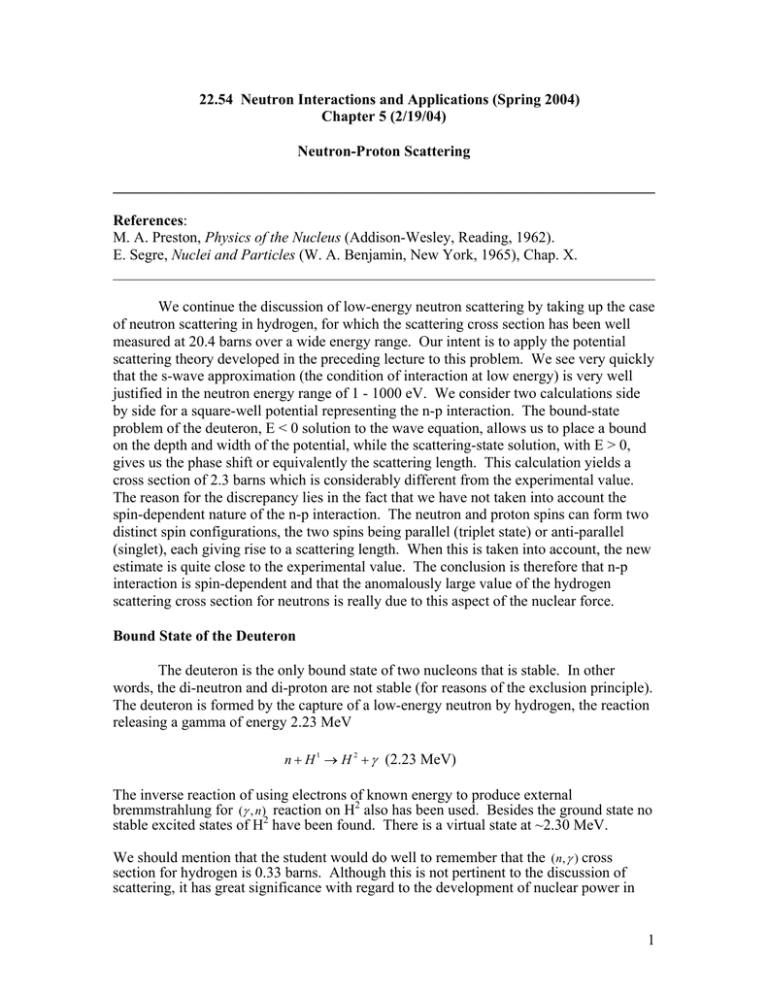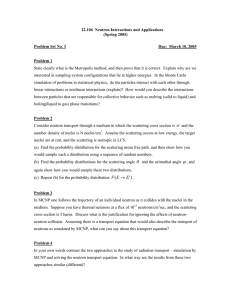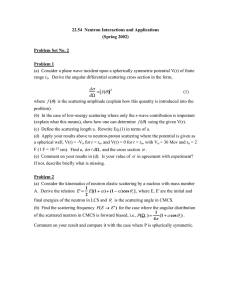22.54 Neutron Interactions and Applications (Spring 2004) Chapter 5 (2/19/04)
advertisement

22.54 Neutron Interactions and Applications (Spring 2004) Chapter 5 (2/19/04) Neutron-Proton Scattering ________________________________________________________________________ References: M. A. Preston, Physics of the Nucleus (Addison-Wesley, Reading, 1962). E. Segre, Nuclei and Particles (W. A. Benjamin, New York, 1965), Chap. X. ________________________________________________________________________ We continue the discussion of low-energy neutron scattering by taking up the case of neutron scattering in hydrogen, for which the scattering cross section has been well measured at 20.4 barns over a wide energy range. Our intent is to apply the potential scattering theory developed in the preceding lecture to this problem. We see very quickly that the s-wave approximation (the condition of interaction at low energy) is very well justified in the neutron energy range of 1 - 1000 eV. We consider two calculations side by side for a square-well potential representing the n-p interaction. The bound-state problem of the deuteron, E < 0 solution to the wave equation, allows us to place a bound on the depth and width of the potential, while the scattering-state solution, with E > 0, gives us the phase shift or equivalently the scattering length. This calculation yields a cross section of 2.3 barns which is considerably different from the experimental value. The reason for the discrepancy lies in the fact that we have not taken into account the spin-dependent nature of the n-p interaction. The neutron and proton spins can form two distinct spin configurations, the two spins being parallel (triplet state) or anti-parallel (singlet), each giving rise to a scattering length. When this is taken into account, the new estimate is quite close to the experimental value. The conclusion is therefore that n-p interaction is spin-dependent and that the anomalously large value of the hydrogen scattering cross section for neutrons is really due to this aspect of the nuclear force. Bound State of the Deuteron The deuteron is the only bound state of two nucleons that is stable. In other words, the di-neutron and di-proton are not stable (for reasons of the exclusion principle). The deuteron is formed by the capture of a low-energy neutron by hydrogen, the reaction releasing a gamma of energy 2.23 MeV n + H 1 → H 2 + γ (2.23 MeV) The inverse reaction of using electrons of known energy to produce external bremmstrahlung for (γ , n) reaction on H2 also has been used. Besides the ground state no stable excited states of H2 have been found. There is a virtual state at ~2.30 MeV. We should mention that the student would do well to remember that the ( n, γ ) cross section for hydrogen is 0.33 barns. Although this is not pertinent to the discussion of scattering, it has great significance with regard to the development of nuclear power in 1 North America. The neutron absorption in water is too high to allow a critical reactor to be built using natural uranium as the fuel and light water as the moderator. The solution adopted in the U.S. was to enrich the natural uranium to a U235 concentration of at least 3% (the U235 concentration in natural uranium is 0.07%). Meanwhile in Canada it was decided to use heavy water as the moderator. Because heavy water has aneutron absorption cross section that is three orders of magnitude lower, a reactor with heavy water moderator can be made critical with natural uranium as the fuel. Given the nuclear data on the deuteron we consider using this information to fit a neutron-proton interaction potential in the simplest possible form, that of a spherical well. The potential is specified by two parameters, a well depth Vo and a range ro, V ( r ) = −Vo r < ro = 0 r > ro (5.1) The question is what values should the parameters take in order to give rise to a bound state at an energy of EB = 2.23 MeV? There is good evidence that the deuteron ground state is primarily 1s (n=1, A =0). Since the lowest energy state predicted by practically all the potential models is an sstate, this is certainly consistent with what we would expect. Secondly, the magnetic moment of H2 is approximately the sum of the proton and the neutron moments, indicating that the two spins are in a parallel configuration and no orbital motion of the proton relative to the neutron. This is compatible with the total angular momentum of the ground state being I = 1. We therefore proceed with fitting the potential through the solution to the radial wave equation (4.10) for A =0 and a negative energy, E = -EB = 2.23 MeV. The fact that the potential is a constant inside the well, r < ro, and zero outside makes the problem separable; the simplest approach would be to solve the wave equation separately in the interior and the exterior regions and apply appropriate boundary conditions to match the two solutions. The two equations are respectively, d2 2 dr 2 + K u ( r ) = 0 , where m is the neutron mass, K = m(Vo − EB ) / = , r < ro (5.2) and d2 2 dr 2 − κ u (r ) = 0 , r > ro (5.3) with κ = mEB / = . The corresponding solutions are: u ( r ) = aeiKr + be − iKr , r < ro (5.4) 2 u ( r ) = ceκ r + de −κ r , r >ro (5.5) Two of the four integration constants can be dispensed with by noting that the wave function must be finite at the origin and that it must remain bounded at infinity. This allows us to put the solutions in the form and u ( r ) = Asin(Kr ) , r < ro (5.6) u ( r ) = de −κ r , r > ro (5.7) Applying the condition of continuity of the ratio of wave function and its derivative at the interface (r = ro), we obtain K cot Kro = −κ (5.8) This is the result we are seeking, namely, a relation between the potential parameters (Vo, ro) and the known binding energy EB. Further reduction is possible because the energies involved are not of the same magnitude. We already know that EB = 2.23 MeV. Although the potential well depth is not known, we have reasons to expect that it will turn out to be about an order of magnitude greater than EB (this will be confirmed below). Thus we proceed under the condition of Vo > EB, in which case (5.8) becomes which implies or, tan( Kro ) = −κ / K ~ Vo / EB (5.9) Kro ~ π / 2 (5.10) Vo ro2 ~ (π / 2) 2 = 2 / m ~ 1 Mev-barn (5.11) We see that (5.9) only allows one to fix the value of Vo ro2 , and not the parameters individually. For neutron-proton interaction, the range can be taken to be ~ 2F (Fermi F = 10-12 cm). Then we have Vo ~ 36 MeV, which is indeed large compared to EB. The spherical-well potential, a square-well in 3-D, thus extracted from the deuteron binding energy is shown in Fig. 5.1. Fig. 5.1. The spherical well potential for neutron-proton interaction with parameters are chosen to give the correct bound-state energy EB = 2.23 MeV. The same potential will be used to calculate the neutron scattering cross section in hydrogen. 3 We next turn to the scattering problem. Our task is to solve the same radial wave equation for s-wave except that now we are looking for solutions with E > 0. The interior and exterior solutions have the form u ( r ) = B sin(K ' r ) , and where K'= m (Vo + E) / = and r < ro (5.12) u ( r ) = C sin(kr + δ o ) , r > ro (5.13) k= mE / = . Applying the interface condition we obtain K 'cot(K ' ro ) = k cot(kro + δ o ) (5.14) which is the relation that allows the phase shift to be determined in terms of the potential parameters and the incoming energy E. We can simplify the task of estimating the phase shift by recalling that it is simply related to the scattering length by δ o = − ak (cf. (4.25)). Assuming the scattering length a is larger than ro, we see the right-hand side of (5.14) is approximately k cot(δ ) . For the left-hand side, we will ignore E relative to Vo in K' , and at the same time ignore EB relative to Vo in K. Then K' ~ K and the left-hand side can be set equal to −κ by virtue of (5.8). Notice that this series of approximations has enabled us to make use of the dispersion relation in the bound-state problem, (5.8), for the scattering calculation. As a result, (5.14) becomes o k cot(δ o ) = −κ (5.17) which is a relation between the phase shift and the binding energy. Once the phase shift δ o is known, the differential scattering cross section is then given by (4.23), σ (θ ) = (1/ k 2 )sin 2 δ o (5.18) A simple way to make use of (5.17) is to note the trigonometric relation 2 sin x = 1 /(1 + cot x ) , or 2 sin 2 δ o = 1 1 + cot δ o 2 = 1 1+ κ 2 / k2 (5.19) 4 Thus, σ (θ ) ≈ 1 k2 +κ 2 = =2 1 m E + EB ≈ =2 mEB (5.20) The last step follows because we are mostly interested in estimating the scattering cross section in the energy range 1 - 100 eV. Putting in the numerical values of the constants, -27 -24 6 -12 = = 1.055 x 10 erg sec, m = 1.67 x 10 g, and and EB = 2.23 x 10 x 1.6 x 10 ergs, we get σ = 4π = 2 / mEB ~ 2.3 barns (5.21) This result is considerably smaller than the experimental value of the scattering cross section of H1, 20.4 barns, as shown in Fig. 5.2. Fig. 5.2. Experimental neutron scattering cross section of hydrogen, showing a constant value of 20.4 barns over a wide range of neutron energy. The rise in the cross section at energies below ~ 0.1 eV can be explained in terms of chemical binding effects in the scattering sample.. The explanation of this well-known discrepancy lies in the neglect of spindependent effects. It was suggested by E. P. Wigner in 1933 that neutron-proton scattering should depend on whether the neutron and proton spins are oriented in a parallel configuration (the triplet state, total spin angular momentum is = ) or in an antiparallel configuration (singlet state, total spin is zero). For each case the interaction potential is different, and therefore the phase shifts also would be different. Following this idea, one can write instead of (5.20), σ (θ ) = 1 1 2 3 sin δ os + sin 2 δ ot 2 k 4 4 (5.22) 5 We have already mentioned that the ground state is the triplet state at E = -EB. If the singlet state produces a virtual state of energy E = E*, then (5.21) would become σ≈ π =2 3 1 + * m EB E (5.23) Taking a value of E* ~ 70 keV, we find from (5.23) a value of 20.4 barns, thus bringing the theory into agreement with experiment. In summary, experimental measurements have given the following scattering lengths for the two types of n-p interactions, triplet and singlet configurations, and their corresponding potential range and well depth. Interaction Scattering length a [F] ro [F] Vo [MeV} n-p (triplet) 5.4 2 36 n-p (singlet) -23.7 ~ 2.5 18 Notice that the scattering length for the triplet state is positive, while that for the singlet state is negative. This illustrates the point of Fig. 4.3. We will have more to say about the scattering length later in the discussion of thermal neutron scattering. 6






